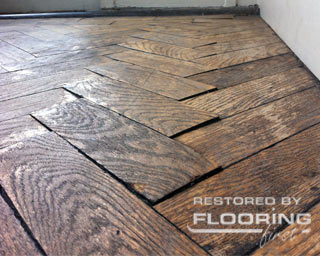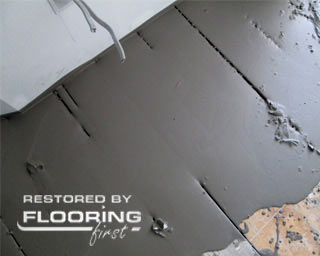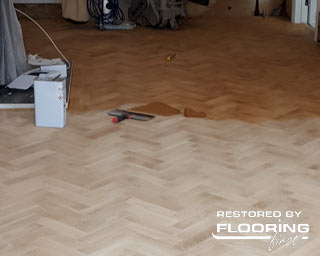Back to Parquet Restoration
Parquet Floor Sanding & Refinishing Guide
Parquet floors have long been admired for their elegance and timeless appeal. Once a symbol of wealth and luxury, these intricate wooden patterns graced the homes of the elite. Restoring an old parquet floor is not just about reviving its appearance - it's about appreciating its inherent value. Like a fine wine, parquet floors only improve with age, becoming stronger and more resilient to wear. But beyond their durability, these floors tell a story—each grain, mark, and groove is a testament to years of history and character. Preserving them means preserving a piece of the past, making them truly irreplaceable.

Preparing the Floor
Every parquet floor repair begins with some mundane tasks. First, the furniture has to be moved and every breakable object in the area has to go. The area must be prepared for the inevitable wood floor sanding which will strip the old finish. To do that, the parquet has to be cleaned thoroughly. Dust particles have abrasive properties and we wouldn’t want them around when the floor sanding starts.
Repairing Old Parquet Flooring
Is the parquet stable? Are any blocks damaged or missing? These are the first questions you should ask yourself. While it is pretty obvious if a block has suffered damage or simply missing, determining whether a block is stable, is a bit trickier. Each section of the parquet floor must be gently tapped to discover which parts produce hollow or rattling sounds. Recovering individual blocks is also tough since pulling even one or two of them can cause a chain reaction and remove a lot more blocks than initially intended.
And here we get to the annoying part - bitumen. Today this black, tar-like substance serves mostly as a road construction material. Victorians, however, used it as a flooring adhesive. The problem with bitumen is that most modern adhesives don’t bond well with it. The material itself is sticky, often brittle and unstable. Bitumen removal from the blocks is quite painful but needed if you want your parquet blocks to be properly secured in place. Unfortunately, removing bitumen from the blocks alone isn’t enough. Alternatively there are suitable primers whcih can help with better bonding with the subfloor.

Taking Care of the Subfloor
Bitumen sticks not only to the parquet blocks but to the subfloor as well. It is strong enough to damage the concrete below the blocks upon removal. This damage makes the subfloor uneven and we cannot refit the parquet back without fixing it first. Most of the time, flooring experts use acrylic levelling compounds to fix the problem. Only once the subfloor is sufficiently levelled, the wood floor repairs can continue by putting the parquet blocks back in their place.
Getting Everything Back Where It Belongs
Wooden floors, parquet included, tend to move a bit as the seasons roll. This is a natural process and cannot and should not be prevented. If we attempt to, the floor may simply buckle. That is why the blocks are fitted with a tiny bit of space between them. Remember that the more bitumen you have stripped, the better will your floor be in the long run. It’s best to use flexible modern adhesive in its stead because it will allow the floor to move a bit. Unfortunately, such adhesives are a bit more expensive.
Sanding the Parquet
Wood floor sanding is divided into three parts – rough, medium and fine. On very uneven wooden floors we begin with coarser sandpaper grits like P24 and slowly transition to finer ones. Parquet flooring, however, is more delicate and rarely uneven. It’s generally better to start with something like P40 and move towards P80. Once we reach it, we are at the second (medium) floor sanding round. When it is done we simply clean and vacuum the floor. The final sanding will occur only after we have filled the gaps between the blocks.
The golden rule of parquet floor sanding is to always follow the grain of the wood. If we don’t, we risk damaging the grain and ruining the impression of a perfectly smooth surface.
Parquetry, however, is made from many wooden blocks arranged in patterns with many pieces facing different directions. How do we sand them all properly? The answer here is that we don’t. The most popular parquet pattern is by far, herringbone. The only correct way to sand herringbone is diagonal. This will allow each side of the parquet blocks to be stripped equally.
Other than that, the sanding procedure is pretty standard. The use of a buffing machine like the Bona Flexi Sand or the Lagler Trio can make the final part of the wood floor refinish a real breeze.
How to Fill the Gaps in Parquet?
 Gap filling is not mandatory but is certainly welcome. Besides improving the appearance of the floor, it can also prevent draughts and save you some money on heating bills during the winter.
Gap filling is not mandatory but is certainly welcome. Besides improving the appearance of the floor, it can also prevent draughts and save you some money on heating bills during the winter.
There are several methods of filling the gaps in your wooden floor. Parquet flooring, however, has relatively small gaps and the preferred way to fill them is by using a mix of sawdust and filler resin. The dust is collected during the floor sanding process and added to the resin. This allows the mixture to acquire the natural colour of the floor and mask the gap pretty well. Bigger gaps are best filled with coarser sawdust collected during the rough floor sanding and smaller ones accordingly – with finer dust collected later on.
Keep in mind that anyone applying the resin should be aware that it dries extremely fast. A bigger knife allows the filling to go faster. Any resin left on the surface will be removed during the third and final sanding round which finally will allow the application of a finish.
Finishing the Job
There are two types of wood floor finish – penetrating oils and lacquers (also known as varnishes). Hardwax oils are a third option which is supposed to combine the qualities of both oil and lacquers but their actual effectiveness is questionable.
Lacquers will form a protective film on the surface of the parquet and provide the best protection out of the three with the least maintenance required. The downside is that the floor begins to look "plastic" and the finish scratches easily.
Oils will soak into the wood and protect it from the inside. They offer a more natural look compared to lacquers but their durability and level of protection are inferior.
Last, we have hard wax oils. A product that works as an oil finish but also forms a film on the surface just like a lacquer. The film, however, is weak and the finish is susceptible to damage caused by liquid spills. Most floor finishes can be applied with an applicator pad and a simple brush but no matter what, the manufacturer’s instructions must be followed to the letter. Once the finish is dry, the wood floor refinishing is complete. Congratulations!